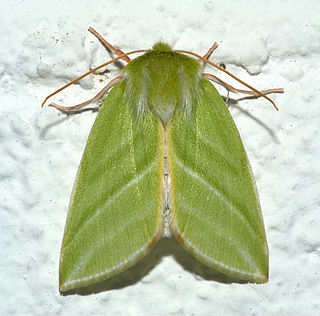
Nolidae is a family of moths with about 1,700 described species worldwide. They are mostly small with dull coloration, the main distinguishing feature being a silk cocoon with a vertical exit slit. The group is sometimes known as tuft moths, after the tufts of raised scales on the forewings of two subfamilies, Nolinae and Collomeninae. The larvae also tend to have muted colors and tufts of short hairs.
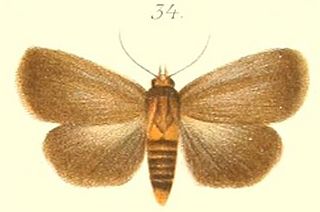
Sympis ochreobasis is a moth of the family Noctuidae first described by Pagenstecher in 1900. It is endemic to the Bismarck Islands of Papua New Guinea.

Pantoporia venilia, the Cape York aeroplane or black-eyed plane, is a butterfly of the family Nymphalidae. It is found in Australia (Queensland), Indonesia, Papua New Guinea and surrounding islands.

Heliozona dulla is a moth of the family Erebidae first described by Arnold Pagenstecher in 1886. It is found on the Kai Islands and Papua New Guinea.
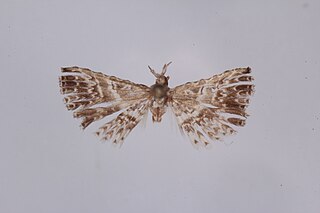
Triscaedecia septemdactyla is a moth of the family Alucitidae. It was described by Pagenstecher in 1900 as Hofmannia septemdactyla. It is found in Papua and Papua New Guinea.

Callidula miokensis is a moth of the family Callidulidae. It is found on the Bismarck Archipelago of Papua New Guinea.
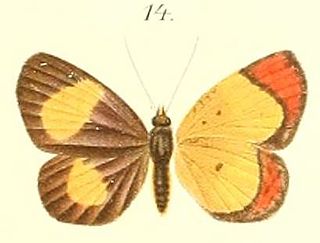
Callidula hypoleuca is a moth of the family Callidulidae. It is found on the Bismarck Archipelago of Papua New Guinea.
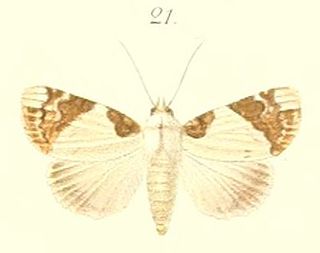
Beana is a genus of moths of the family Nolidae. The genus was erected by Francis Walker in 1862.

Micronia notabilis is a species of moth of subfamily Microniinae of family Uraniidae that is found in Papua New Guinea. The species was first described by Arnold Pagenstecher in 1900.

Caprinia versicolor is a species of moth of the family Crambidae. It was described by Arnold Pagenstecher in 1900 and it is found in Papua New Guinea.

Didiguides is a monotypic moth genus of the family Nolidae erected by Lutz W. R. Kobes in 1994. Its only species, Didiguides semifervens, was first described by Francis Walker in 1863. It is found on Borneo, Sumatra and Sulawesi, as well as in New Guinea and on the Bismarck Islands. The habitat consists of dipterocarp forests, including alluvial forests.
Cyme basitesselata is a moth of the subfamily Arctiinae.

Risoba repugnans is a species of moth of the family Nolidae first described by Francis Walker in 1865.

Glyphodes nitidaria is a moth of the family Crambidae described by Arnold Pagenstecher in 1899. It is known from the Bismarck Archipelago of Papua New Guinea.
Aquis orbicularis is a moth of the family Nolidae first described by Francis Walker in 1858. It is found in the Indian subregion, Sri Lanka, Peninsular Malaysia, Papua New Guinea and Borneo.
Giaura tortricoides is a moth of the family Nolidae first described by Francis Walker in 1865. It is found in Sri Lanka, Japan, Andaman Islands, Borneo, Sumatra, Flores, Sulawesi, New Guinea, Bismarck Islands and Australia.

Paracrama dulcissima is a moth of the family Nolidae first described by Francis Walker in 1864. It is found in Indo-Australian tropics of India, Sri Lanka and the Bismarck Islands.
Etanna basalis is a moth of the family Nolidae first described by Francis Walker in 1862. It is found in Borneo, Sri Lanka, Myanmar, Thailand, New Guinea, Australia, Vanuatu and Fiji.
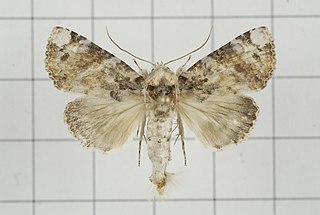
Beana terminigera is a moth of the family Nolidae first described by Francis Walker in 1858. It is found in India, Sri Lanka, Nepal, Thailand, Myanmar, Peninsular Malaysia, Borneo and the Philippines.
Labanda saturalis is a moth in the family Nolidae first described by Francis Walker in 1865. It is found in Indo-Australian tropics of India, Sri Lanka, and from New Guinea to the Solomon Islands.















